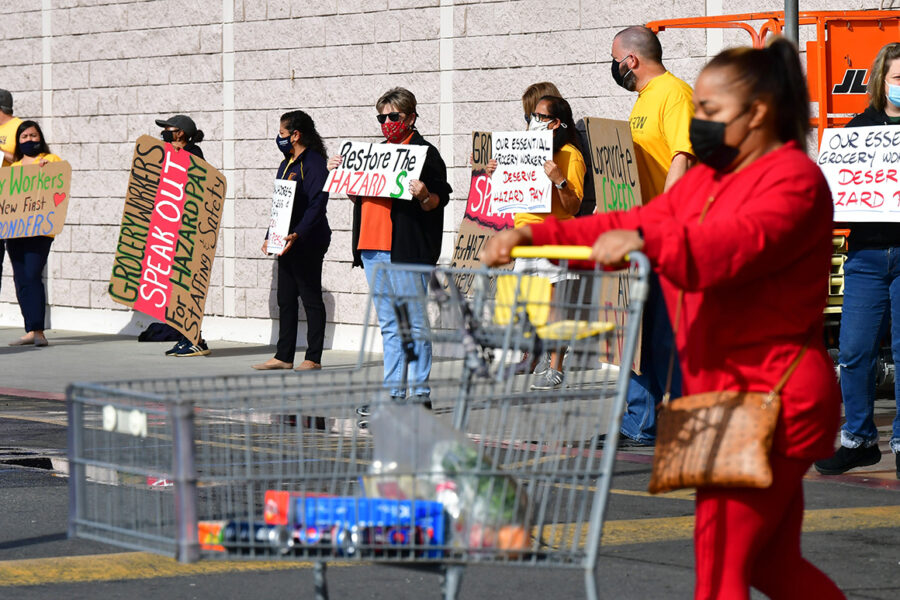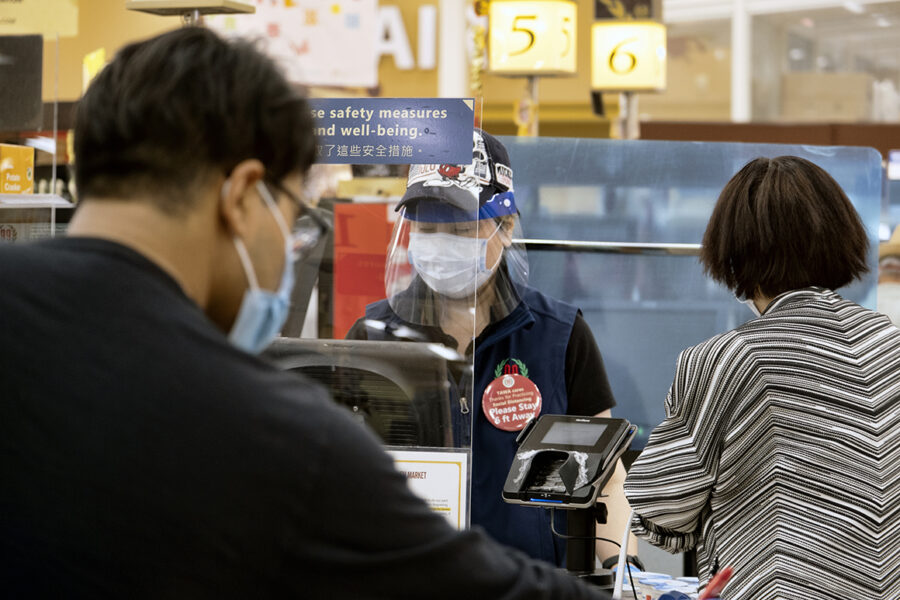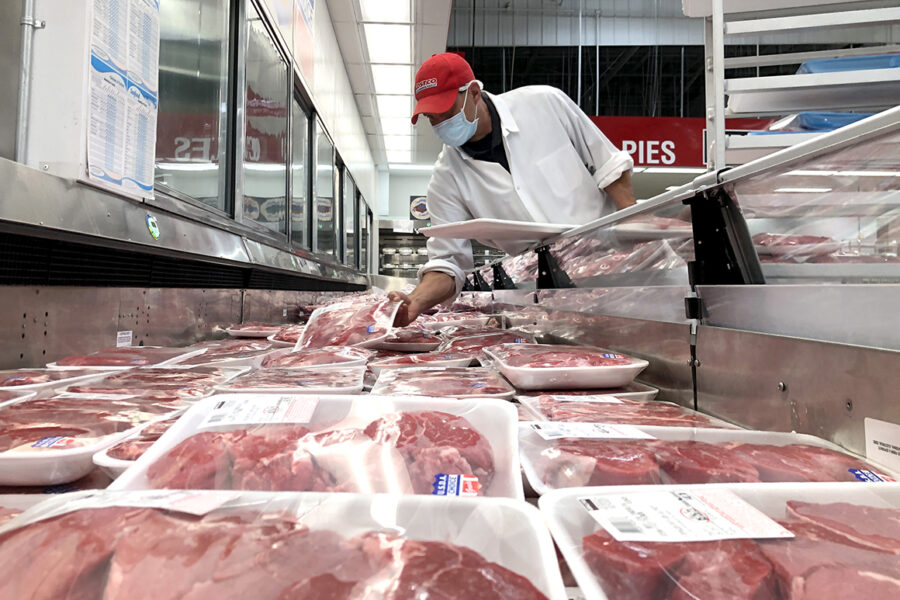‘They need to be recognized’: How grocery workers’ fight for hazard pay will impact the economy long-term

LOS ANGELES — Tony Campanello, who runs the frozen food section at a Ralphs supermarket in Long Beach, has worked in nearly every department of the store since taking the job nearly 44 years ago.
He has seen the name on the front of the store and his uniform change numerous times over those years and said he often felt unappreciated, like he was “just a number” to the sprawling grocery conglomerate that owns Ralphs.
Then the pandemic hit.
In the early days, unsure of how the virus spread, everyone with the ability to stay home, did — and wiped down their mail and groceries with disinfectant. But like so many other employees deemed “essential” when the country shut down, Campanello and his coworkers didn’t have that option. Instead, they continued to show up at work and do their jobs, despite being in “fear for our own lives.”
Signs began to pop up around the state calling essential workers heroes and thanking them for their service. Kroger, the corporate giant that owns Ralphs, even briefly offered their workers a $2 per hour pay bump and a $400 bonus early in the pandemic.
That surreal period underscored a truth that activists had been pointing to for years but that hadn’t made its way into mainstream politics: Many of the workers we couldn’t live without are paid the least for their so-called essential labor.
Company hazard pay didn’t last long, but a few dozen cities and counties in California extended the practice for a few months this year in a kind of natural experiment: Would a boost in salary for lower-wage workers lead to tangible benefits for them and their communities without bankrupting their employers?
In January, the City Council in Long Beach voted to require grocery employers to pay frontline workers an extra $4 per hour for 120 days — an idea that would have been unthinkable in a pre-pandemic world.

Businesses, union leaders and labor market economists agree that the push for mandated hazard pay began late last year after a Brookings Institution report showed that companies like Kroger and Amazon reported huge profits during the first two quarters after the country shut down, but stopped providing hazard pay voluntarily by June of last year.
This year’s extra pay brought about by city ordinance proved to be critical for Campanello, helping him grow his savings and cover first and last month’s rent on a new apartment after he unexpectedly had to move — an already stressful process made worse by a booming regional housing market. More important, he said, was that the extra pay made him feel that grocery workers had been recognized as people of value.
“For Long Beach to say, these guys are up front, they need to be recognized for it, yeah, that made me feel a lot better about everything,” he said. “As far as being a human being goes.”
Campanello is among the millions of essential workers around the country who have received pay increases since the pandemic began. Those funds have come in a range of sizes and forms — from $1,000 bonuses for teachers in Georgia to $4 per hour raises for state employees in Montana.
In effect, the pandemic forced Americans to recalculate the value of workers in traditionally low-wage sectors in a way that hasn’t occurred in recent memory. White-collar workers were largely able to hunker down at home during the pandemic, even as they had to cancel vacations, skip dinners out, or attend to “Zoom school.” But essential workers experienced a far different pandemic, and it became clearer than ever that our economy and social systems needed their workplaces — like the local grocery store or pharmacy — to stay open to function.
“Clearly the value [low-wage workers] are providing, the value they’re adding to services and so on, was probably higher than was previously perceived,” said Michael Tanner, a senior fellow at the libertarian Cato Institute.
Hazard pay and other pandemic-related pay increases have proven to be a boon for many essential workers, helping them pay for medical bills or save for a rainy day. Industry groups, however, say those policies could force some smaller employers out of business or cause them to think twice about operating in a higher-wage city.
In no state have these policies been more popular than California. Following the lead of Long Beach, 37 cities and counties have passed temporary ordinances this year that require certain grocery and retail businesses to pay employees $4 to $5 more per hour. Only a handful of cities outside of the state, including Seattle, have similarly required employers to cover worker pay increases themselves.
California’s $14 hourly minimum wage is already the second-highest in the country behind Washington, D.C., but a $4 to $5 per hour pay bump represents a significant increase for many of the state’s low-wage workers, increasing their paychecks by up to 35 percent.
In California and across the country, wages for lower- and middle-class workers have been stagnant for decades, even as the economic productivity of companies has grown. The inflation-adjusted hourly earnings for low-wage workers increased by just 4 percent in California from 1979 to 2018, according to the left-leaning California Budget and Policy Center.
Unions and anti-poverty activists have argued for years that many American workers are paid too little to live on and have pushed for higher minimum wages, among other policies. Business groups have argued that paying higher wages would force them to cut the number of workers they could employ.
In some ways, the pandemic provided a chance to see which side might be right; while the results are somewhat mixed, it’s clear that the lives of workers like Campanello did improve markedly even from the short-term increases.
Months into the pandemic, as businesses continued shutting down and unemployment was soaring, Jackie Lopez looked for a job in the grocery industry, where she hoped to find more job security after the liquor store where she’d worked cut her hours.
A mother of three young children who lives in Huntington Park, a small city southeast of Los Angeles, Lopez was hired as a part-time clerk at El Super, a regional chain of supermarkets.
Lopez said she knew her new job would come with risks, but being out of work wasn’t an option.
“I was nervous before I started working,” she said. “I knew it was a possibility that I was going to run into people that were sick or who didn’t want to comply with the rules with masks and six feet distance.”
In late December, as Covid cases were raging through Los Angeles, Lopez noticed during a lunch break that she had begun to lose her sense of smell and taste. Terrified, she rushed to get herself and her family tested. She was infected, along with her husband and her parents, whom they’d recently visited.
Lopez said that only her mother suffered serious symptoms, ending up in the hospital before recovering. But for two weeks, she and her husband — who also works at a grocery store — couldn’t work, and they fell behind on their bills. Neither she nor her husband initially qualified for sick-leave pay, though they did receive it retroactively under a federal law passed in March.
It was around this time that Lopez heard about the hazard pay proposal that Los Angeles County, where her store is located, would soon adopt. For 120 days starting in March, the county required grocery stores and some retailers to give their workers $5 more per hour.
Lopez still remembers the first time it materialized on a paycheck. Her husband, who works in the city of Compton, did not receive hazard pay. But the extra money just in her paycheck allowed the family to catch up on their bills, including late credit card payments, she said. It also let them treat their kids to meals out, a trip to Universal Studios and a few hours on a whale-watching boat.
“It felt more comfortable knowing that we have that little bit of savings, and we could take the kids out to places,” she said. “It felt really good.”
The pay increases did come with complications for workers in some places, as store managers tried to offset the increased salary costs in other ways. Full-time employees who’d worked 40-hour weeks for years at Lopez’s store complained about receiving fewer hours. Part-time employees who typically had 30-hour weeks started working rotating schedules where they’d receive 30 hours one week and 24 hours the next.
Lopez said that unpopular new schedule lasted about three weeks before returning to normal. She said she’s not sure why that decision was made, but that employees had been preparing to take up the issue with their union.
The higher paychecks came until late June, when Los Angeles County’s ordinance ended.
Her hazard pay savings have already begun to run out, but the temporary increase could have a lasting effect: It has allowed the couple to expand their new party rental business, which they started in January. They’d been planning for years to start their own business, a dream postponed by the pandemic.
The extra funds Lopez received this year helped buy a second inflatable bounce house, along with balloons and gas for their delivery truck. The money also provided her with peace of mind that the business could survive a slow period.
“It was like a relief to say, okay, just in case we have a whole month of bad business, I know I’m going to be able to rely on my work check,” she said.
With Covid restrictions beginning to lift, Lopez said the business has been booked for events every weekend. It recently had its first corporate gig, creating balloon arches and arrangements for a Kaiser hospital. Her sights are now set on becoming a fixture in the local community, and maybe someday, becoming an employer instead of an employee.
“I want to be recommended to a big customer and have them say, ‘Oh yeah, I’ve heard of them. They’re local, they’re from Huntington Park.”
Of course, the hazard pay experiment looks different from the employer point of view.
Industry groups argue that Long Beach’s higher wages ended up harming businesses and workers alike. Kroger closed five underperforming stores in Long Beach and Los Angeles after those cities enacted hazard pay. Other stores slashed employee hours.
The pay mandate pushed some small, independent businesses into debt during those months, grocery and retail trade groups say, which has forced them to cut costs and, in some cases, to consider closing. Larger firms, they say, are likely to cut back on charitable contributions.
“If you raise your expenses in labor, you’ve got to cut your expenses somewhere,” said Ronald Fong, president of the California Grocers Association.

Organizers from the United Food and Commercial Workers, which led the hazard pay fight, say the industry criticisms are overblown, noting that most grocery stores have remained open. They also point to the Brookings report, which showed Kroger’s voluntary pay boosts amounted to just 87 cents per hour while the company’s net earnings rose by 90 percent in the first and second quarters of last year to $2 billion.
“Some of the biggest and most important companies, when you think of frontline workers, are sitting on vastly elevated profits, even sometimes huge amounts of cash, and absolutely have the ability to do more for their workers,” said Molly Kinder, a fellow at the Brookings Institution.
If labor trends continue, they might have to start.
Hazard pay, voluntary bonuses and other labor market shifts during the pandemic reset the expectations for earnings across the income spectrum, from highly paid tech workers to low-wage cashiers. More than 9 million jobs are unfilled, according to the Bureau of Labor Statistics.
Economists say one long-term impact of the pandemic is that essential workers now recognize that they are essential and are reluctant to return to roles they see as underpaying.
“Employers are desperate for employees right now,” Tanner said, “and the process of finding them could by itself force them to raise wages, particularly in some of these jobs that turned out to be higher risk than was previously thought.”
Go To Source
Author: POLITICO

